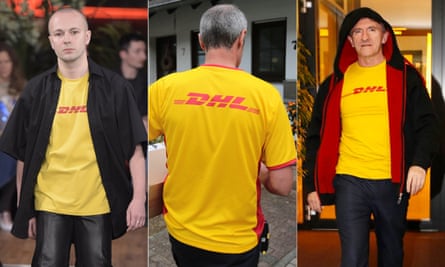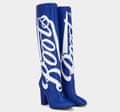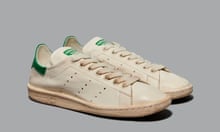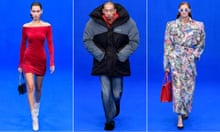On 1 October 2015, a man walked out on to the Vetements catwalk in Paris. He wore Dr Martens boots, shiny black trousers, an open black shirt and what was to become the It item of spring/summer 2016: a DHL T-shirt. The reaction fell into two camps: one, furiously snapping pictures to post on Instagram; the other, quizzical. Paris is traditionally the world of sequin gowns, champagne on trays and sets that cost millions, after all.
A T-shirt with such a prosaic logo really threw down the gauntlet. Vetements – a label known for wonky 90s-influenced streetwear, real-world models and oversized fits, designed by a collective headed by Demna Gvasalia – had arguably brought anti-fashion back to fashion.

The shirt went on sale in the middle of January at high-fashion retailers. The hype quickly reached hysteria. It has now sold out at most retailers, despite a price tag of £185. In the frenzy to get their hands on it, some enterprising fashion fans even took to DHL’s own website, where they could buy an almost identical T-shirt for $6.50 (£4.50). If they ordered 100. I got swept up, too: in February, I bought a DHL T-shirt on eBay for £25.

Models, bloggers, stylists and photographers made it an Instagram staple. It spawned parody memes. Even Ken Allen, the chairman of DHL, was photographed wearing the Vetements T-shirt in March. The image appeared on GQ’s website, in Look magazine, on Refinery29.com. It prompted The Man Repeller to write a post confessing she “didn’t get Vetements” and the Daily Mail to lead the “would you pay £185 for this T-shirt?” collective eyeroll. Heige Rieder, who oversaw the branding of DHL in the 90s, wrote in the Financial Times that the T-shirt was “ugly” and the price tag “totally nuts”. So far, so the biggest fashion story of 2016.
What did it all mean? Was it a brilliant subversion or blatant scam? A comment on global capitalism or a high-fashion conspiracy?
“They are hacking the fashion system,” believes trends analyst Aleksandra Szymanska of the Future Laboratory, “and they’re credible [enough] to make these statements of capitalist kitsch.” It’s true that Vetements has an outsider pedigree. Led by Georgian-born 34-year-old Gvasalia, it has staged shows in gay nightclubs and Chinese restaurants in unfashionable areas of Paris since launching in 2014. Previous collections have included a jumper like the ones worn by security guards in France and a mac similar to those worn by German police. Speaking to the Guardian last year, Gvasalia said: “We give existing pieces new life.” They’re worn by Kanye West, Justin Bieber, Rihanna and Selena Gomez. Of his aesthetic, a grinning Gvasalia has also said: “It’s ugly, that’s why we like it.”

Szymanska has been tracking the use of everyday brands in fashion for the past two years, from Vetements to Moschino (McDonald’s, Barbie) and Anya Hindmarch (Kellogg’s, Daz, Swan Vestas matches, Boots, John Lewis, Carrefour). She thinks this is different. “It [DHL] creates a stronger surreal note than Anya. It is ominous and powerful that this can become so desirable.” Rather than Andy Warhol’s Campbell’s Soup Cans painting and Hindmarch’s domestic pop moments, this is colder, in the spirit of Ed Ruscha: desolate gas stations, industrial estates and corporate slogans.
While fashion has rejected logos over the past decade, there’s little doubt that they are back. “There’s a different definition of luxury now. It’s about an attention-grabbing visual statement,” says Szymanska. Humour – a relatively new concept to fashion – is also playing a part. Unlike the noughties’ logomania, when the brand’s logo – Louis Vuitton’s LV or Chanel’s double C – was an ostentatious symbol of how rich the wearer was, fashion brands now use non-fashion logos, because they are catnip on social media, where visual gags rule. “I think it says we’re confident enough to wear something a bit funny,” says Hindmarch. “I don’t really like logos that say ‘look at who I am wearing.’”

Sure, the constant updating on the average Instagram feed means the popularity of the much-liked item is almost over before it has begun but, if you can keep pace, it can equal big business. Hindmarch’s company made £28.4m in sales last year, partly thanks to her Insta-friendly brand designs, while Vetements has played the modern fashion system, making sure demand outstrips supply, and providing one after another of these meme-worthy designs. As a result, Gvasalia is now at fashion’s top table. Along with Vetements, he is the creative director of Balenciaga.
DHL represents globalisation – it delivers to every country in the world bar Turkmenistan – so its yellow and red branding, worn by a 300,000-plus workforce, is familiar to all. But it has the grit of a working uniform, unlike a brand with the cultural pedigree of, say, Coca-Cola.
DHL itself is the first to admit it is not the obvious choice for a catwalk moment. But Chairman Allen says they were happy to grant Vetements permission to “take something that many people might see as ordinary and giving it an extraordinary twist”. Allen is now enjoying the cool factor, wearing the same T-shirt as K-pop star G-Dragon. “I’ve been telling my wife, kids and friends for years now just how sexy the DHL brand is,” he says. “Finally, having seen my photo in GQ, I think they’re ready to agree with me!”

Perhaps the ultimate irony is that there is almost no twist at all. The only difference between this T-shirt and the one available to buy in bulk, worn by actual couriers, is the stripe that goes around the back, and a fit designed to be worn bunched at the waist. But, as the pop art references suggest, context is all. It’s possible to take Vetements’ DHL stunt back to Duchamp’s urinal in an art gallery in 1917, through Warhol’s Brillo boxes in 1964, the Situationists’ Paris 1968-approved détournement – taking a well-known image and creating a version of it in opposition to its original meaning – and to the culture-jamming movement of the late 80s and early 90s, when anti-capitalism activists defaced adverts with protest: “feed me” in a speech bubble next to a model in a Calvin Klein advert, for example.
The tradition of using logos as a playful form of resistance in fashion was last big in the 90s, too. While some catwalk brands – including Maison Margiela, where various members of the Vetements team used to work – were involved, it boomed in skate culture, when labels including Fuct used the Ford logo but with their own preferred four letters in the oval design. “It was a bit of a game, everything was heavily copyrighted and they would get a cease-and-desist letter,” says Patrick Burgoyne, editor of Creative Review, and author of Board: Surf, Skate, Snow Graphics. “It wouldn’t matter, because by that point, they would have moved on to the next one.”
In 1999, writing in No Logo, Naomi Klein voiced the anti-corporate feeling of a decade, but observed a generation who are “now finding ways to express their disdain for mass culture not by opting out of it but by abandoning themselves to it entirely – but with a sly ironic twist.” This idea is alive and well. There’s Brian Litchenberg’s sweatshirts, substituting Hermes for Homies and Paris for South Central to great in-lol-ing in the past five years. And there’s contemporary skate and street brands. Sportsbanger mixes the Nike swoosh with blue branding of the NHS, and Pearshaped plays with the Apple logo, so inherent to millennial lives, by turning it into a pear. The British skateboard brand Palace uses the recycling logo, and also has a T-shirt with an in-the-know image of an ecstasy tablet with the Mitsubishi logo. Supreme, meanwhile, collaborated with White Castle and Playboy to delight its skate bro fanbase and upset Morrissey – a staunch vegetarian and now reluctant Supreme campaign star – in equal measure.
Burgoyne is perplexed by the Vetements version because it comes without the joke, or appears to, anyway. “Clothes with corporate logos usually have a gag, some sort of point of view or subversion,” he says. “This is straight up – perhaps now there is so much corporate control that the most subversive thing to do is to have the thing in the actual form. But for me, DHL has never represented the evils of global capitalism – it is far too ordinary.” Maybe that’s sort of the point: in a next-level normcore way, the ordinary – rather than unattainable glamour – is in fashion. Amy Lee, strategy director of Wolff Olins, the agency that designed the London 2012 logo, says: “Referencing a prosaic brand on their clothes is a shortcut to social realism. It’s also a challenge, asking people the question what they consider to be fashion.”

Angela McRobbie, professor of media and communications at Goldsmiths and author of Be Creative: Making a Living in the New Culture, is dismissive of the “low-grade irony” of the T-shirt but does concede “there is some desire for the ordinary and the unremarkable … a preference for the dreary, where high fashion induces nausea”. She believes that Vetements, as with other logo players, aren’t being critical of the fashion system – they’re too busy making their way in it: “I despair for the fashion economy today. How can you be critical and socially engaged when to survive you also have to be commercial?” she asks. As for putting the T-shirt in a tradition of brand subversion, she says: “It’s too slick and too easy. The thing is, fashion graduates nowadays have all studied cultural theory and read a good deal of British subcultural theory, but this writing is shorn of its radical and critical import, as well as awareness of its socio-historical context … In a social media-dominated world, there is a hunger for novelty.”
As McRobbie asks, can fashion designers – part of the establishment, collaborating with corporate brands rather than ripping their images, and selling them for £185 a pop – really make something that is anti-fashion? It could be argued that Gvasalia is having the last laugh, trying to topple the system from within. But does that still hold when the brand he is sending up is in on the act? Not according to Kalle Lasn, editor of Ad Busters, and a leader in the culture-jamming movement. “We’re obsessed with brands and the workings of capitalism,” he says. “We’re accepting this is the way of the world by accepting this collaboration between Vetements and DHL. I find that enraging.” Lasn does admit there’s a clever idea behind it. “I hate this story but I feel like there is some comment on late capitalism. It’s smart to pull a prank like this.”
The new world order for logos, fashion and branding has changed. Look at Gvasalia’s reaction when a young designer Davil Tran created a jacket with “Vetememes” written on the back instead of Vetements last month. The parody went viral, as might be expected, but there was no law summons in the post. Instead, Gvasalia wished Tran well, telling the New York Times that Vetements hopes “that he has enjoyed making his project as much as we do making our clothes”. Fake, parody, homage or original? Those distinctions are so over. In fashion 2016, it’s all fair game.










Comments (…)
Sign in or create your Guardian account to join the discussion